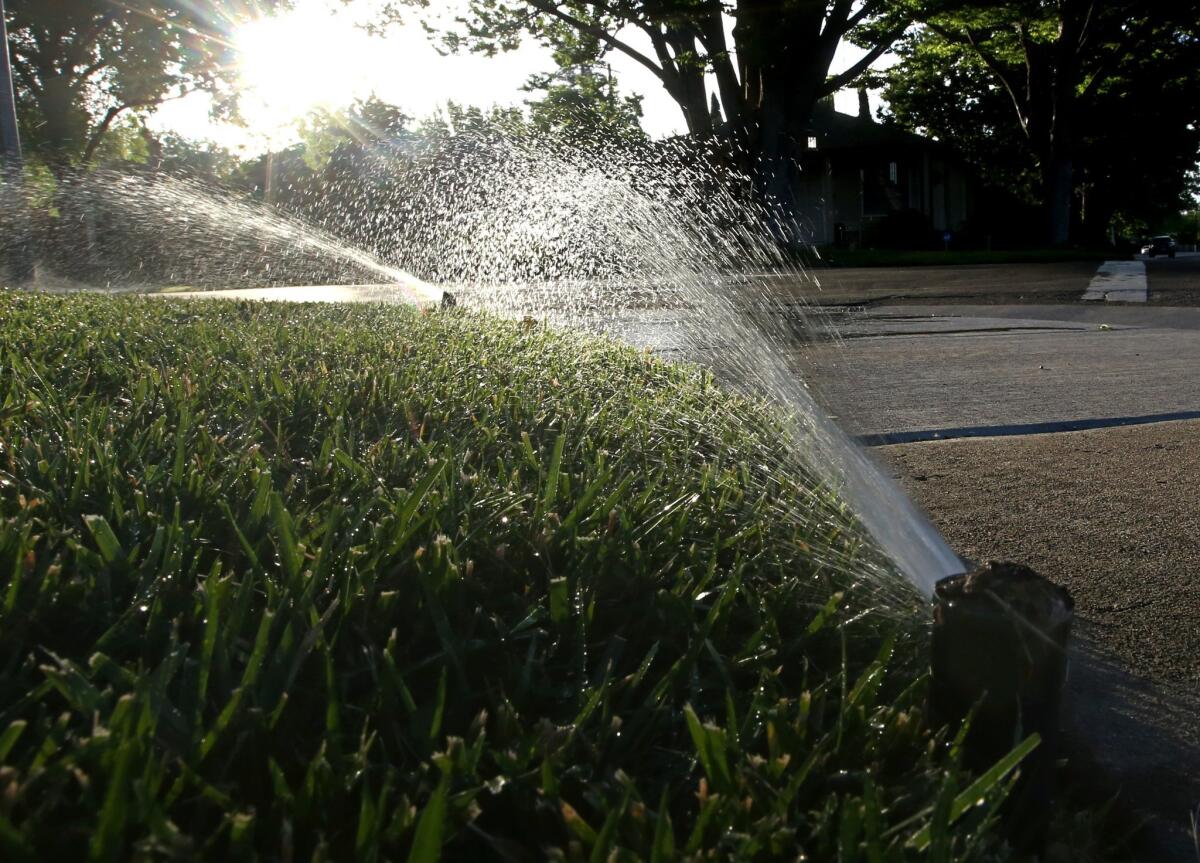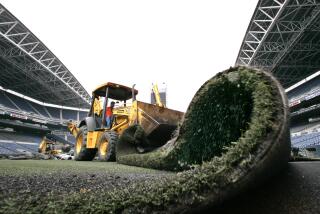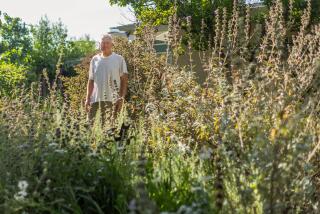Op-Ed: Deprogamming the Southern California lawn

A lawn in Sacramento, Calif. is irrigated on May 27. California’s drought-stricken cities set a record for water conservation, reducing usage 29 percent in May, according to data released by a state agency Wednesday, July 1.
My first lawn in Southern California was at a Burbank rental where the landlord asked my husband and me to keep the yard watered. A dewy-eyed newbie to this end of the state, I thought, “Not a problem.” The landlord paid for the water and it was mid-1980s cheap.
But the joke was on us. The house didn’t have a sprinkler system or shade trees, and the oven-baked grounds went from verdant to toasty in no time. Just before we moved in July, I was determined to see how much water it would take to revive the grass with a roving sprinkler head attached to a hose. Answer: five hours a day for multiple days.
It was my first encounter with the pathology of Western lawns. I thought their prevalence in the even then drought-stricken Los Angeles highly questionable, if not somewhat insane. At the first house we bought, on a lawn-free hillside in Glendale, we eventually put in a drought-tolerant garden appropriate to the sun-kissed conditions. Still, I was surprised at the significant rise in our monthly water bills.
Right now, I’m embarrassed to say, we’re surrounded by a lush expanse of shared lawn and gardens in a Westside condominium community. The biggest patch is great for Frisbee tossing with my dog, but I cringe at its water claims and dread the weekly droning of the lawn mower. I’ve suggested changing some purely decorative patches to water-wise alternatives such as yarrow, the lawn substitute used for decades at Highland Park’s historic Lummis House. Yarrow can be walked on, it flowers, and it doesn’t need to be mowed more than eight times a year.
My suggestions have so far gone nowhere.
Now that we are deep into California’s worst recorded drought and Gov. Jerry Brown has called lawns a thing of the past, some lawn lovers are finally open to change — but not all, even when threatened with skyrocketing water rates and potential fines.
What’s with our death grip on vast expanses of turf? My digging has uncovered a painful example of the fallacy of free will. While the state gasps for water, many of us keep pouring the precious stuff into these outdoor carpets because, in part, our lawns mark us as middle-class homeowners.
According to lawn historians (yes, books have been written on the subject), the obsession stretches back centuries to European and American garden designers. A great cloak of trimmed grass surrounding an estate signaled wealth, that the land wasn’t required for buildings or food crops. Think Downton Abbey or Thomas Jefferson’s Monticello.
Fast-forward to 20th century Middle America, and these Elysian Fields become our little patches of suburban pride. Every house in Levittown, N.Y., came with a lawn. This suburban turf rollout from the rainy East Coast to the arid West was Manifest Destiny expressed in blades of blue fescue and St. Augustine grass.
We’d still be trimming our symbols of economic attainment with baaing sheep or whistling scythes if it weren’t for lawn mowers. The manual push mower was shoved aside for gas models in the early 20th century, soon followed by pesticides and synthetic fertilizers, and suddenly there was a major multibillion-dollar industry devoted to loudly maintaining increasingly toxic swaths of sod. Estimates now suggest there are 49,000 square miles of lawn in the U.S., our single largest irrigated crop.
A passion for lawn may also predate middle-class aspirations. “The Golden Bough,” Scottish anthropologist James George Frazer’s 1890 book on comparative religion, suggested that pagan fertility-cult rituals of death and resurrection — Christianity’s earliest inklings — offered the comforting suggestion of eternal life. The king dies, the king is reborn; Jesus dies, Jesus is reborn; Elvis dies, Elvis is reborn — you get the picture.
Might these beliefs, in our secular times, extend to lawns? The lawn is mowed, the lawn is reborn. Faithful homeowners observing the tenets of proper lawn care can take solace in the weekly resurrection cycle.
So, DWP, if you can just get us to give up our deep-seated, no longer sustainable beliefs that lawns represent middle-class standing and the promise of eternal life, we might be more eager to take you up on that rip-out-the-grass rebate offer. A more rational approach to landscaping in our arid climate might even put some of the golden back in the Golden State — that is, after all, the true color of our native grasses much of the year.
Nancy Spiller is the author of the novel “Entertaining Disasters” and the memoir “Compromise Cake: Lessons Learned From My Mother’s Recipe Box” and a teacher in the UCLA Extension Writers’ Program.
Follow the Opinion section on Twitter @latimesopinion and Facebook
More to Read
A cure for the common opinion
Get thought-provoking perspectives with our weekly newsletter.
You may occasionally receive promotional content from the Los Angeles Times.










